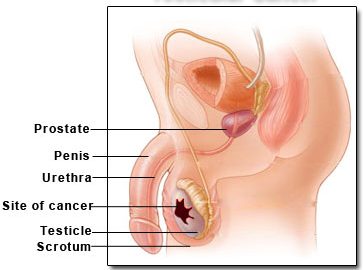Testicular cancer
Testicular cancer is usually diagnosed when the patient finds a lump on the body of the testicle. It is very important that patients get used to performing regular testicular self examination. It is important to differentiate between lumps associated with the epididymis, and lumps on the body of the testicle. Lumps on the epididymis are rarely serious. All lumps of the body of the testicle need urgent assessment, to rule out the possibility of a testicular tumour.
Treatment
If confirmed on ultrasound the testicle will need to be removed. Prior to this, some blood tests will be taken, and you will also need to have a CT scan done. This will see if there is evidence that the tumour has spread beyond the testicle. Prior to the operation to remove the testicle, you will also be asked if you would like to have your sperm banked. If so, this will be arranged.
The operation is done under a general anaesthetic, through an incision is made in the groin. The testicle is removed through this incision. You will be asked before the operation if you want to have a prosthesis(artificial testicle) inserted at the time of you operation.
Follow up
Following surgical removal of the testicle, the pathologist will determine under the microscope what type of tumour is present. You will then be seen by an oncologist who will decide if any further treatment such as chemotherapy is required.
Prognosis
The vast majority of testicular tumours are completely curable.
More information
Cancer Research UK: testicular cancer
Cancer Backup information on testicular cancer
Orchid :Orchid exists to save men’s lives from testicular, prostate and penile cancers through pioneering research and promoting awareness





